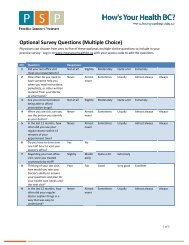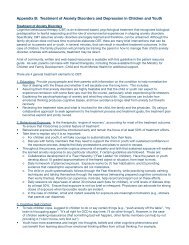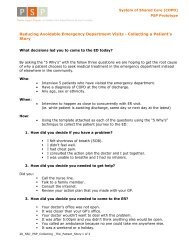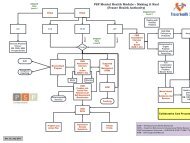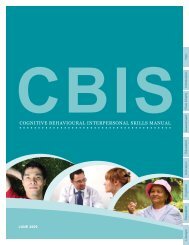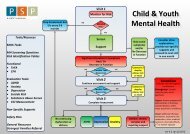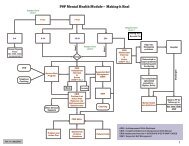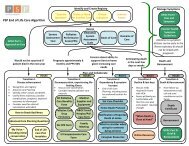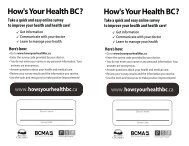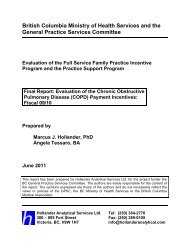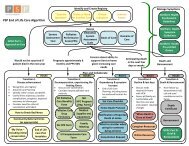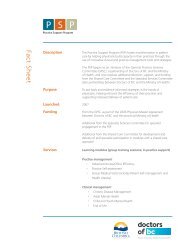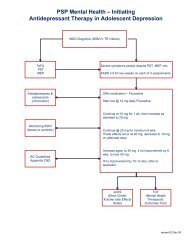Alcohol Use Disorders Identification Test (AUDIT) - GPSC
Alcohol Use Disorders Identification Test (AUDIT) - GPSC
Alcohol Use Disorders Identification Test (AUDIT) - GPSC
You also want an ePaper? Increase the reach of your titles
YUMPU automatically turns print PDFs into web optimized ePapers that Google loves.
The <strong>Alcohol</strong> <strong>Use</strong> <strong>Disorders</strong> <strong>Identification</strong> <strong>Test</strong><br />
Practice Support Program<br />
Scoring and Interpretation of Scores:<br />
Total scores of 8 or more are recommended as indicators of hazardous and harmful alcohol<br />
use, as well as possible alcohol dependence. (A cut-off score of 10 will provide greater<br />
specificity but at the expense of sensitivity.) Since the effects of alcohol vary with average body<br />
weight and differences in metabolism, establishing the cut off point for all women and men over<br />
age 65 one point lower at a score of 7 will increase sensitivity for these population groups.<br />
Selection of the cut-off point should be influenced by national and cultural standards and by<br />
clinician judgment, which also determine recommended maximum consumption allowances.<br />
Scores between 8 and 15 are most appropriate for simple advice focused on the reduction of<br />
hazardous drinking.<br />
Scores between 16 and 19 suggest brief counseling and continued monitoring.<br />
Scores of 20 or above clearly warrant further diagnostic evaluation for alcohol dependence.<br />
In the absence of better research these guidelines should be considered tentative, subject to<br />
clinical judgment that takes into account the patient’s medical condition, family history of alcohol<br />
problems and perceived honesty in responding to the <strong>AUDIT</strong> questions.<br />
While use of the 10-question <strong>AUDIT</strong> questionnaire will be sufficient for the vast majority of<br />
patients, special circumstances may require a clinical screening procedure. For example, a<br />
patient may be resistant, uncooperative, or unable to respond to the <strong>AUDIT</strong> questions. If further<br />
confirmation of possible dependence is warranted, a physical examination procedure and<br />
laboratory tests may be used.<br />
<strong>AUDIT</strong> score Intervention<br />
Risk Level <strong>AUDIT</strong> Score (1) Suggested intervention<br />
Zone I 0-7 <strong>Alcohol</strong> education<br />
Zone II 8-15 Simple advice<br />
Zone III Simple 16-19 Advice plus brief counseling and continued monitoring<br />
Zone IV 20-40 Referral to specialist for diagnostic evaluation & treatment<br />
(1) The <strong>AUDIT</strong> cut-off score may vary slightly depending on the country’s drinking patterns, the<br />
alcohol content of standard drinks, and the nature of the screening program. Clinical judgment<br />
should be exercised in cases where the patient’s score is not consistent with other evidence, or<br />
if the patient has a prior history of alcohol dependence. It may also be instructive to review the<br />
patient’s responses to individual questions dealing with dependence symptoms (Questions 4, 5<br />
and 6) and alcohol-related problems (Questions 9 and 10). Provide the next highest level of<br />
intervention to patients who score 2 or more on Questions 4, 5 and 6, or 4 on Questions 9 or 10.<br />
Source: The <strong>Alcohol</strong> <strong>Use</strong> <strong>Disorders</strong> <strong>Identification</strong> <strong>Test</strong>. Guidelines for <strong>Use</strong> in Primary Care, Second Edition, World<br />
Health Organization 2001<br />
2 of 2 Mar 23, 2009 Mental Health Module



